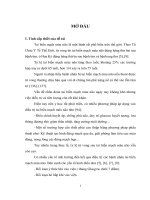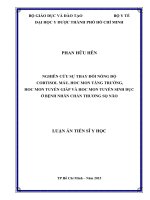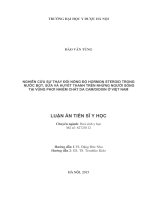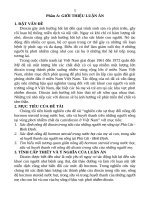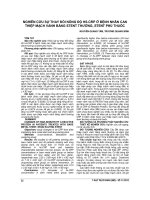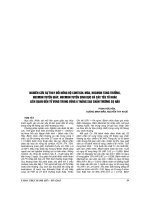Nghiên cứu sự thay đổi nồng độ cytokin huyết tương trong lọc máu liên tục bằng màng lọc oxiris ở bệnh nhân sốc nhiễm khuẩn tt tiếng anh
Bạn đang xem bản rút gọn của tài liệu. Xem và tải ngay bản đầy đủ của tài liệu tại đây (1.03 MB, 31 trang )
MINISTRY OF EDUCATION AND TRAINING
MINISTRY OF DEFENCE
108 INSTITUTE OF CLINICAL MEDICAL AND PHARMACEUTICAL
SCIENCES
---------------
PHẠM QUỐC DŨNG
STUDY ON THE CHANGES OF PLASMA CYTOKINE
CONCENTRATION IN CONTINUOUS HEMOFILTRATION WITH
THE MEMBRANE ADSORBING OXIRIS FILTER IN SEPTIC
SHOCK PATIENTS
Speciality: Anesthesia and Critical Care
Code: 62.72.01.22
ABSTRACT OF MEDICAL PHD THESIS
Hanoi – 2020
THE THESIS WAS DONE IN: 108 INSTITUTE OF CLINICAL
MEDICAL AND PHARMACEUTICAL SCIENCES
Supervisor:
1. M.D., PhD. Đo Quoc Huy
2. Ass. Prof. PhD. Le Thi Viet Hoa
Reviewer:
1.
2.
3.
This thesis will be presented at Institute Council at: 108 Institute of
Clinical Medical and Pharmaceutical Sciences
Day
Month
Year
The thesis can be found at:
1. National Library of Vietnam
2. Library of 108 Institute of Clinical Medical and Pharmaceutical
Sciences
1
INTRODUCTION
Septic shock is a common disease in intensive care unit.
Currently, despite progress in diagnosis and treatment, the fatality
rate from septic shock remains as high as 40-55%.
The "cytokine storm" has been known in the pathophysiology of
septic shock and is a condition in which the body's over-immune
response to infection causes massive release of cytokines into the
bloodstream.
Treatment of septic shock was agreed by Sepsis-3 (2016) with
treatment packages including volume therapy, vasopressor use,
infection resolution and other supportive measures. Continuous
hemofiltration using adsorbing filter that has been recently used
helps to remove cytokines (TNF-α, IL-1b, IL-6, IL-8, IL-10) in the
hope of stopping the vicious circle of septic shock.
The oXiris filter has many outstanding advantages compared to
other adsorbing filters or devices and is the only filter that adsorbs
both bacterial endotoxins and cytokines with safe use and few
complications.
So far, continuous hemofiltration technique using the oXiris
adsorbing filters in treatment of septic shock has not been much
researched. With the value of adsorbing hemofiltration and the
advantages of the oXiris filter, the project of "Study on the changes
of plasma cytokine concentration in continuous hemofiltration
with the membrane adsorbing oXiris filter in septic shock patients"
was conducted for two goals:
1. Evaluating changes in plasma cytokine concentrations in
continuous hemofiltration with the membrane adsorbing oXiris filter
in patients with septic shock.
2
2. Comment on some clinical and subclinical changes in septic
shock patients undergoing continuous hemofiltration with the
membrane adsorbing oXiris filter.
3
Chapter 1
LITERATURE OVERVIEW
1.1. Introduction to cytokine
1.1.1 Definition
Cytokines are proteins or glycoproteins produced and released
by white blood cells and some other cells. Cytokines typically have a
molecular weight from 8 to 30 kiloDaltons and act as intercellular
chemical messengers. All cytokines are involved in the immune
response to protect the host against pathogens and/or to regulate the
inflammatory response.
1.1.2. Classification of cytokine
- Interleukin (IL): currently about 40 types of interleukin have been
found, denoted from IL-1 to IL-40.
- Interferon (IFN): there are three types of IFN: α, β and γ.
- Tumor necrosis factor (TNF): including 18 types, eg TNF-α,
CD40L, FasL, etc.
- Cerebrospinal fluid (CSF) stimulating factors: including M-CSF,
GM-CSF, G-CSF, EPO, SCF, TPO
- Chemokine: 4 groups of CC, CXC, C and CX3C.
1.1.3. Cytokine release syndrome and cytokine storm
- Cytokine release syndrome (CRS) is a systemic inflammatory
response syndrome resulting from complications of certain diseases
or infections and also a side effect of some monoclonal antibody
drugs as well as cancer immunotherapy.
- Cytokine storm: A cytokine storm is a severe case of CRS.
1.1.4. Some types of cytokine in research
- Tumor Necrosis Factor-α (TNF-α): tumor necrosis factor is an
inflammatory cytokine with molecular weight of 17 kiloDalton.
4
TNF-α is selective cytotoxicity to a variety of transgenic cells,
especially when the cell is bound to INF-α.
- Interleukine 1b (IL-1b): lymphocyte activating factor, is an
inflammatory cytokine with molecular weight of 18 kiloDaltons,
produced by activated macrophages. The increased IL-1b remains in
patients at high risk of fatality.
- Interleukine 6 (IL-6): is an inflammatory cytokine with molecular
weight of 21 kiloDaltons. IL-6 regulates B and T cell functions,
hematopoiesis, and acute phase response. IL-6 is the most effective
stimulant in the production of proteins in hepatic acute phases. It is
the second messenger released by macrophages, endothelial cells or
fibroblasts and other cells in response to IL-1b and TNF-α cytokines.
- Interkeukine 8 (IL-8): is an inflammatory cytokine with molecular
weight of 8 kiloDaltons. IL-8 is an inflammatory chemokine
produced by multiple cells, especially mononuclear cells, and
functions as an activating and chemical attracting factor in
polymorphonuclear leukocytes. IL-8 is a very powerful vascular
agent. The presence of IL-8 causes neutrophils to attach to the
capillary endothelial cells and move into the tissues.
- Interkeukine 10 (IL-10): is a potent anti-inflammatory cytokine,
with molecular weight of 18 kiloDaltons. IL-10 is a cytokine
secreted by Th0 and Th2 cells, a subset of T lymphocytes (CD4). IL10 inhibits the activation of cytokine synthesis of Th1 cells, activated
mononuclear cells and NK cells.
5
1.2. Septic shock
1.2.1. Definition
- Septic shock is considered a subtype of sepsis, in which circulatory
and cellular metabolic abnormalities are severe enough to increase
mortality (Sepsis-3, 2016).
- Septic shock is diagnosed based on criteria for diagnosis of sepsis
together with persistent hypotension, which requires the use of
vasopressors to maintain mean arterial blood pressure ≥ 65 mmHg
and serum lactate ≥ 2 mmol/l (18mg/dl) despite full volume
compensation.
1.2.2. Mechanism of pathogenesis
Immune mechanisms (cytokine storms: an increase in blood
cytokines such as TNF-α, IL-1, IL-6, IL-8, IL-10 ...) is a major factor
in the pathogenesis of septic shock. There are three important
components involved in this pathogenesis, including:
- Pattern recognition receptor (PRRs): are proteins expressed on cells
of the innate immune system to recognize pathogen associated
molecular patterns (PAMPs) and/or damage-associated molecular
patterns (DAMPs).
- Pathogen associated molecular patterns (PAMPs): are antigenic
types associated with etiologic groups (gram-negative bacteria are
LPS, gram-positive bacteria are LTA) identified by cells of the
innate immunity system.
- Damage-associated molecular patterns (DAMPs): are multistructural, multi-functional host proteins released in response to
infection or tissue damage.
6
1.2.3. Treatment of septic shock
Early diagnosis, settlement of septic foci, appropriate
antibiotics and initial resuscitation are the cornerstones of the
treatment.
1.3. Continuous hemofiltration using oXiris filter
1.3.1. Continuous Veno-Venous Hemofiltration (CVVH) in
supporting treatment of septic shock
- Continuous veno-venous hemofiltration is a method using only the
ultrafiltration - convection mechanism in which blood runs through
the filter with replacement fluid inserted in front or after the filter
and without using dialysis Fluid. Due to the ultrafiltration convection mechanism and large enough rate of replacement fluid, it
is also possible to remove very well substances with high molecular
weight such as inflammatory mediators of TNF-α, IL-1, IL-6, IL-8,
IL-10, in addition to removing solutes.
- Hemoperfusion is a method of filtering the blood extracorporeally
that uses devices containing adsorbents (adsorbent devices). An
adsorbent device can be an adsorption filter that can adsorb and/or
adsorbent cartridges/columns to eliminate toxins or pathogens
(endotoxins, cytokines, etc). Hemoperfusion is performed in the
same way as regular continuous hemofiltration, but the blood is
passed through a filter that adsorbs or through a sorbent container, in
which "toxins" like cytokines, bacterial endotoxins, etc. are adsorbed
into the surface of filter or adsorbing cartridges/columns.
1.3.2. oXiris filter
- oXiris filter is manufactured based on AN69 filter (Figure 1.9).
1.3.3.
Domestic
and
international
hemofiltration using oXiris filter
studies
on
continuous
7
International studies:
Currently,
researches
in
the
world
on
continuous
hemofiltration using oXiris filter with endotoxin and cytokine
absorption properties in the treatment of septic shock are quite rare.
Through literature reference, only about 13 studies are found, of
which there are 5 quantitative studies about cytokines in the blood.
Fig.9. The 3 layers of the oXiris membrane. PEI,
polyethyleneimine
Domestic studies:
Continuous hemofiltration was transferred into Vietnam in
2002. Since then, this technique has been routinely used in a number
of major hospitals across the country. There, however, are few
studies in Vietnam. OXiris membrane has just appeared in the
8
Vietnamese market. Currently, only one report by Le Huu Nhuong
(2017) on the effectiveness of continuous hemofiltration using oXiris
filter is found but not on subjects of septic shock.
Chapter 2
RESEARCH SUBJECTS AND METHODOLOGY
2.1. Research subject
31 patients in 03 intensive care units (ICU) of Thu Duc District
Hospital, 115 People's Hospital, Bach Mai Hospital from September
2014 to October 2018.
2.1.1. Criteria for selecting patients
- Patients ≥ 18 years of age who were diagnosed with septic
shock according to Sepsis-3, maintained systolic blood pressure ≥ 90
mmHg by infusion and vasopressors in ICU and had APACHE II
score at admission ≥ 25 or acute kidney damage or mechanical
ventilation. The patient's relatives agreed to participate in the study.
2.1.2. Criteria for exclusion
- Patients who did not agree to participate in the study.
-
Patients
who
had
contraindications
to
continuous
hemofiltration techniques, irreversible shock unresponding to
therapy and vasopressors.
2.1.3. Venue of study
The intensive care units of Thu Duc District Hospital, 115
People's Hospital, Bach Mai Hospital.
2.2. Research methodology
2.2.1. Research design: prospective study, intervention study, case
control study.
2.2.2. Research equipment and tools
9
- Medical reports by designed forms.
- Prismaflex version 7.1; oXiris filter; Hemosol filtration solution;
12F double-barrel catheter; Monitor to monitor invasive arterial
blood pressure; Infusion machine.
- Evidence machine for quantifying cytokine. Ventilators (Puritan
Bennett 840, Hamilton).
2.2.3. Study steps
2.2.3.1. Time of data collection
- Time T1= commencement of continuous hemofiltration.
- Time T2= continuous hemofiltration for 8 hours.
- Time T3= continuous hemofiltration for 24 hours
- Time T4= continuous hemofiltration for 48 hours
- Time D2= measure cytokine in ultrafitrate after 8 hours of
continuous hemofiltration
- Time D3= measure cytokine in ultrafitrate after 24 hours of
continuous hemofiltration.
2.2.3.2. Resuscitation and treatment of patients before performing
continuous hemofiltration by oXiris filter
- Clinical examinations and subclinical tests were performed,
patients were included in research samples when qualifying all
selection criteria.
- Resuscitation and rehydration of septic shock were carried out
according to the agreed regimen approved by the Hospitals. Patients
with respiratory failure would be intubated and ventilated according
to the instructions.
- Clinical examination, careful investigation of medical history,
search of primary infection sites, assessment of hemodynamics,
monitoring of organ failure progress (APACHE II and SOFA
10
scores), surgical intervention to resolve the infection foci
(pancreatitis acute gangrene, abscess drainage, etc) were performed.
- Blood tests: hematology, biochemistry, immunology, diagnostic
imaging, arterial blood gas, cytokine quantification, blood culture,
antibiotic map.
2.2.3.3. Technical procedure for continuous hemofiltration using
oXiris filter
It was according to the continuous hemofiltration process
developed by the research team and approved by the Hospital
Science Council of Thu Duc District, the People's Hospital 115 and
Bach Mai Hospital.
2.2.3.4. Process to quantify the concentration of cytokines (TNF-α,
IL-1b, IL-6, IL-8, IL-10) in the blood and hemofiltration solution
Quantification of plasma cytokine concentrations using the
Evidence machine; Accredited laboratory according to ISO 15189:
2012
Blood:
- Blood samples (02 ml) were taken from the peripheral vein,
stored in a test tube without anticoagulant and sent immediately to
the biochemistry-immunology laboratory. The samples then would
be centrifuged at 3,000 rpm for 5 minutes. Plasma fractions were
used to measure cytokine concentrations. The test samples were
frozen at -700 ° C if they were not used immediately.
- The cytokine concentration (TNF-α, IL-1b, IL-6, IL-8 and IL10) was quantified by biochips technology, the fully automatic
immune photochemistry.
- Detection threshold: concentration of TNF-α was 3.7 pg/ml, of
IL-1b was 7.8 pg/ml, of IL-6 was 0.4 pg/ml, of IL-8 was 3.9 pg/ml
11
and of IL-10 was 1.1 pg/ml
- The time of taking blood for cytokine test was documented.
Cytokine concentrations (TNF-α, IL-1b, IL-6, IL-8 and IL-10) in
plasma were collected.
- Calculate the rate of cytokine excretion in blood:
𝑇ℎ𝑒 𝑟𝑎𝑡𝑒 𝑜𝑓 𝑐𝑦𝑡𝑜𝑘𝑖𝑛𝑒 𝑒𝑥𝑐𝑟𝑒𝑡𝑖𝑜𝑛 (%)
[𝐶𝑦𝑡𝑜𝑘𝑖𝑛𝑒] 𝑏𝑒𝑓𝑜𝑟𝑒 − [𝐶𝑦𝑡𝑜𝑘𝑖𝑛𝑒] 𝑎𝑓𝑡𝑒𝑟
=
𝑥100
[𝐶𝑦𝑡𝑜𝑘𝑖𝑛𝑒] 𝑏𝑒𝑓𝑜𝑟𝑒
Note: [cytokine]: mean cytokine concentration in blood (ng/ml)
For example: cytokine excretion rate (%) at T1-T2 =
[𝐶𝑦𝑡𝑜𝑘𝑖𝑛𝑒] 𝑎𝑡 𝑇1 − [𝐶𝑦𝑡𝑜𝑘𝑖𝑛𝑒] 𝑎𝑡 𝑇2
𝑥100
[𝐶𝑦𝑡𝑜𝑘𝑖𝑛𝑒] 𝑎𝑡 𝑇1
Ultrafitrate
=
- The procedure for testing the cytokine concentration in the
ultrafitrate was almost the same as that in the blood
- The ratio of the concentration of ultrafitrate TNF-α (or IL-1b,
IL-6, IL-8 and IL-10) to the plasma at the same times of T2, T3.
𝑇ℎ𝑒 𝑟𝑎𝑡𝑖𝑜 𝑜𝑓 𝑡ℎ𝑒 𝑐𝑦𝑡𝑜𝑘𝑖𝑛𝑒 𝑐𝑜𝑛𝑐𝑒𝑛𝑡𝑟𝑎𝑡𝑖𝑜𝑛 𝑖𝑛 𝑈𝑙𝑡𝑟𝑎𝑓𝑖𝑡𝑟𝑎𝑡𝑒
𝑣𝑒𝑟𝑠𝑢𝑠 𝑃𝑙𝑎𝑠𝑚𝑎 𝑎𝑡 𝑡ℎ𝑒 𝑠𝑎𝑚𝑒 𝑡𝑖𝑚𝑒𝑠 =
[
]
[
]
2.2.3.5. Design research form for each patient
- Information of population: age, gender, work, address, etc.
- Medical history.
- Clinical features include diagnosis, infectious entry and number of
dysfunctional organs at T1, T2, T3, and T4 times.
- The severity of the disease was assessed using the APACHE II
scores at T1 time and SOFA at T1, T2, T3, and T4 times.
- Evidence of pathogenic microorganisms was obtained by blood
cultures, bacterial strains were isolated and bacterial identification
12
was made.
- Subclinical tests such as blood cytology, complete coagulation,
blood biochemistry (ions, blood sugar, urea, creatinine, bilirubin,
GOT, GPT, PCT, lactate, blood gas, concentrations of some blood
cytokines at T1, T2, T3, and T4 times; concentrations of some
ultrafiltrate cytokines at T2, T3 times were performed.
- Number of hospitalized days in intensive care unit. Percentage of
ventilators and days of ventilation.
- Vasopressors (drug type, dose). The vasopressor index was
calculated = Dopamine (mcg/kg/min) x1 + Dobutamine (mcg/kg/min)
x1
+
Epinephrine
(mcg/kg/min)
x100
+
Norepinephrine
(mcg/kg/min) x100 + Vasopressin (U/kg/min) x 10,000
- Average vasopressor index (average VIS): is the average of the VIS
at 4 times: before continuous hemofiltration and after continuous
hemofiltration 8 hours, 24 hours, 48 hours.
- The rate of complications during hemofiltration (hemorrhage,
hypothermia, electrolyte disturbances, technical problems).
- Results of treatment (survival, fatality).
2.2.4. Criteria
- Criteria for diagnosing septic shock: according to SCC 2016 criteria
- Criteria for diagnosing organ failure: evaluating 6 organs according
to Knaus Criteria
- Criteria for discontinuation of continuous hemofiltration: patient
with shock escape (criteria of shock escape: systolic blood pressure>
90 mmHg and vasomotor discontinuation for more than 1 hour with
hemodynamic stability); reduced renal failure (with urine> 50
ml/hour and blood creatinine <150 µmol/L (1.7 mg/dl); PaO2/FiO2>
250.
13
- Normal values of cytokines in the study
In blood: TNF <11 pg/ml; IL-1b <14,5 pg/ml; IL6 <1,23 pg/ml;
IL 1-159,4 pg/ml; IL-10 <1,9 pg/ml
In ultrafitrate: None.
2.3. Data processing
IBM SPSS statistics software 21 was used. Qualitative variables
were presented as frequencies and percentages. 2 or more ratios were
compared using the χ2 test. If a quantitative variable had a normal
distribution, it would be displayed as mean ± SD. If the quantitative
variable had no normal distribution, then it would be displayed as
median ± interquartile range. Two mean values were compared using
t-test. Two median values were compared using the Wilcoxon or the
Mann-Whitney U test. Comparison of three or more median values
was repeated on a sample using the Friedman test.
2.4. Research design
14
Patients selected for the study:
- Age ≥18 with diagnosed septic shock (Sepsis-3)
- Systolic blood pressure remains ≥ 90 mmHg
- With AKI or ventilation or APACHE II ≥25
Exclusion criteria
- Irreversible shock unresponding to therapy and vasopressors
- With acute severe organ disease
- HIV-AIDS
- Without agreement to participate in the study
Patients with septic shock as specified by criteria are collected in the study
with continuous hemofiltration
n=37
Continuous hemofiltration using oXiris filter
n=32
Continuous hemofiltration using M100 filter
n=5
Excluded from the study
Result analysis
n=31
- Characteristics of the study group
- Quantifying Cytokine concentrations in plasma and hemofiltration effluent
- Recognizing haemodynamic status
- Recognizing progressive multiorgan dysfunction
- Recognizing complications of continuous hemofiltration
- Survival/Mortality ratio
Conclusion
1. Evaluating changes in plasma cytokine concentrations in continuous hemofiltration with the membrane adsorbing oXiris filter
in patients with septic shock.
2. Comment on some clinical and subclinical changes in septic shock patients undergoing continuous hemofiltration with the
membrane adsorbing oXiris filter.
15
Chapter 3
RESEARCH FINDINGS
3.1. Common characteristics of patients
- The study was made on 31 patients with septic shock, mean age of
62.03 ± 15.79 (26-97). Patients> 60 years old accounted for a high
rate of 67.3% of age. Male/female ratio = 0.72/1. The SOFA score at
the beginning of hemofiltration was 16.2 ± 4.8 points. The most
common primary infection was the respiratory tract, followed by the
digestive tract, urinary tract and other organs. Among infectious
agents, the rate of Acinetobacter baumannii was most commonly
encountered. In addition, some other types such as Escherichia coli,
Klebsiella spp, etc. were also encountered.
- The time of hospitalization was 13.6 ± 11.3 days; the time in
intensive care unit was 11.0 ± 11.4 days; 72 oXiris filter were used
for 31 patients, the mean lifespan of oXiris filter was 16.2 ± 10.3
hours. Continuous hemofiltration with oXiris filter was safe with
very few complications.
- The survival rate was 48.4%, the mortality rate was 51.6%.
3.2. Evaluating changes in plasma cytokine concentrations in
continuous hemofiltration (CHF) with the membrane adsorbing
oXiris filter in patients with septic shock
Table 0.20. Concentration of cytokine at the beginning of CHF
Cytokine
Normal (pg/ml)
median (25th-75th), n=31
TNF-α
< 11
13.06 (6.34 – 22.41)
IL-1b
< 14.5
5.0 (1.7 – 7.65)
IL-6
< 1.23
665.1 (147.73 – 1095.0)
IL-8
1 – 159.4
710.2 (198.0 – 1351.0)
IL-10
< 1.9
21.91 (7.88 – 51.4)
16
Most plasma cytokin concentrations before
continuous hemofiltration are higher than normal values.
Comment:
Table 0.1. The change of plasma TNF-α concentration
Cytokine TNF-α, median (25th- Friedman Test
Times
75th), n=31
T1
13.06 (6.34 – 22.41)
T2
12.05 (5.82 – 19.76)
χ2 = 6.34
T3
9.76 (6.25 – 29.43)
p = 0.096 (>0.05)
T4
9.84 (5.70 – 19.00)
Comment: The median value of the TNF-α concentration tends to
decrease during continuous hemofiltration, but this change is not
statistically significant.
Table 0.2. The change of plasma IL-1b concentration
Cytokine IL-1b, median (25th- Friedman Test
Times
75th), n=31
T1
5.0 (1.7 – 7.65)
T2
5.0 (1.9 – 5.95)
χ2 = 12.938
T3
5.0 (2.1 – 7.22)
p = 0.005 (<0.05)
T4
4.65 (1.58 – 5.41)
Comment: The median value of the IL-1b concentration shows a
statistically significant difference in continuous hemofiltration
Table 0.3. Wilcoxon Signed Ranks Test for IL-1b
T2-T1
T3-T2
T4-T3
T1-T4
T1-T3
T2-T4
Z
-1.473
-.495
-3.054
-1.884
-0.202
-2.172
p (2 sides)
0.141
0.620
0.002
0.011
0.840
0.03
17
Comment: There is a difference in IL-1b concentration at the time
before continuous hemofiltration, at 8 hours and 24 hours compared
to the time at 48 hours with statistical significance
Table 0.4. The change of plasma IL-6 concentration
Cytokine IL-6, median (25th-75th), Friedman Test
Times
n=31
T1
665.1 (147.73 – 1095.0)
T2
470.66 (126.74 – 1021.0)
χ2 = 4.237
T3
480.44 (114.93 – 1153.24)
p = 0.237 (>0,05)
T4
371.23 (70.8 – 1207.54)
Comment: The median value of the IL-6 concentration tends to
decrease gradually during hemofiltration, but this difference is not
statistically significant.
Table 0.5. The change of plasma IL-8 concentration
Cytokine IL-8,
median
(25th- Friedman Test
Times
75th), n=31
T1
710.2 (198.0 – 1351.0)
T2
342.86 (80.7 – 1351.0)
χ2 = 22.878
T3
110.7 (41.0 – 600.27)
p = 0.000 (<0.05)
T4
148.0 (35.6 – 313.57)
Comment: The median value of the IL-8 concentration tends to
decrease gradually during continuous hemofiltration, this difference
is statistically significant.
Table 0.6. Wilcoxon Signed Ranks Test for IL-8
18
T2-T1
T3-T2
T4-T3
T1-T4
T1-T3
T2-T4
Z
-1.594
-2.523
-1.694
-3.644
-3.142
-2.562
p (2 sides)
0.111
0.012
0.098
0.000
0.002
0.01
Comment: There are differences in IL-8 levels at the time before
continuous hemofiltration (T1) compared to that at 24 hours (T3) and
48 hours (T4); there is a difference in the concentration of IL-8 at the
time of continuous hemofiltration at 8 hours (T2) compared to that at
24 hours (T3) and 48 hours (T4).
Table 0.7. The change of plasma IL-10 concentration
Cytokine IL-10, median (25th- Friedman Test
Times
75th), n=31
T1
21.9 (7.88 – 51.4)
T2
12.5 (7.33 – 33.06)
χ2 = 13.311
T3
9.38 (4.73 – 31.78)
p = 0.004 (<0.05)
T4
9.15 (3.36 – 25.76)
Comment: The median value of the IL-10 concentration tends to
decrease gradually during continuous hemofiltration, this difference
is statistically significant.
Table 0.8. Wilcoxon Signed Ranks Test for IL-10
T2-T1
T3-T2
T4-T3
T1-T4
T1-T3
T2-T4
Z
-0.832
-0.820
-2.232
-2.476
-0.638
-1.867
p (2 sides)
0.405
0.412
0.025
0.013
0.524
0.026
Comment: There is a difference in IL-10 levels at the time before
continuous hemofiltration, at 8 hours, 24 hours compared to that at
48 hours after continuous hemofiltration.
19
Table 0.29. The change of cytokine concentrations in ultrafitrate
Cytoki
D2 (8 hours) (n=23)
D3 (24 hours) (n=23)
ne
cytokine of
Percentage cytokine of
Percenta
X ± SD
ultrafiltrate
compared
ultrafiltrate
ge
(pg/ml)
(pg/ml)
to blood
(pg/ml)
compare
d to
blood
TNF-α
3.1 ± 2.3
7.6
2.6 ± 1.3
6.2
IL-1b
30.8 ± 19.6
80.8
11.9 ± 7.8
33.2
IL-6
465.5 ± 154.1
43.5
285.1 ± 124.0
19.2
IL-8
4.54 ± 3.12
0.8
5.31 ± 4.02
1.4
IL-10
1.42 ± 0.90
1.4
1.32 ± 0.67
1.3
Comment: At the time of 8 and 24 hours after continuous
hemofiltration, all cytokines are present in the ultrafitrate, the
percentage of cytokine in ultrafitrate to that in plasma is as follows:
IL-1b (80%) is the highest, followed by IL-6 (43.5%), the lowest is
IL-8 (0.8%).
3.3. Comment on some clinical and subclinical changes in septic
shock patients undergoing continuous hemofiltration with the
membrane adsorbing oXiris filter
Table 0.30. Hemodynamic changes in the study group
Parameter
T1, n=31
T2, n=31
T3, n=31
Pulse (l/p)
116.2 ±
103.7 ±
93.2 ±
22.5
21.7
22.2
HATB
61.3 ± 12.1 69.3 ± 17.3
70.5 ±
(mmHg)
16.2
vasopressor120.5 ±
60.2 ± 32.4
21.1 ±
inotrope score
44.7
11.7
T4, n=31
91.2 ± 14.2
83.6 ± 15.8
15.2 ± 10.2
Comment: pulse, mean blood pressure are improved and the
vasomotor need is decreased.
20
Table 0.31. Biochemical changes in the study group
Parameter
T1, n=31 T2, n=31 T3, n=31
Creatinin X ± SD 2.1 ± 0.9
1.7 ± 0.9
1.6 ± 0.8
≥1,5
16
13
12
PTC
X ± SD
9.1 ± 4.5
5.2 ± 3.1
4.5 ± 2.5
Lactat
X ± SD
6.0 ± 4.2
4.0 ± 2.8
3.7 ± 2.1
T4, n=31
1.5 ± 0.7
12
3.1 ± 2.1
3.0 ± 1.5
Comment: creatinin, Procalcitonin, Lactat are all improved
(gradually decreasing) after continuous hemofiltration, starting at 8
hours after continuous hemofiltration.
Table 0.33. Change in the progression of organ failure in the
study group
Parameter
T1, n=31
T2, n=31
T3, n=31
T4, n=31
SOFA
16.2 ± 4.8
12.1 ± 3.2
10.5 ± 2.9
10.3 ± 4.1
Comment:
The mean SOFA score is improved gradually with
continuous hemofiltration.
21
Graph
0.1. ROC curve of IL-1b and IL-6 at the time of
continuous hemofiltration for 48 consecutively in the prognosis
of mortality in study patients.
Comment: At the time of 48 hours of continuous hemofiltration, the
concentration of IL-1b and IL-6 have a good value of prognostic
fatality with AUC of 0.783 (p = 0.007) and 0.762 (p = 0.013),
respectively.
Chapter 4
DISCUSSION
4.1. General characteristics of study patients
The average age in this study is appropriate since septic shock
can occur at any age. According to the author Nasa P, 2012: septic
shock can occur at any age but commonly at the age of over 50 years
old, most commonly at the age of over 60 years old.
4.2. Evaluation of changes in plasma cytokine concentrations in
continuous hemofiltration using oXiris filter in patients with
septic shock
4.2.1. Changes of blood cytokine concentration
Cytokine concentration prior to continuous hemofiltration
using oXiris filter
The median values of cytokines (TNF-α, IL-6, IL-8, IL-10) are
all higher than normal physiological values, consistent with the study
subjects as septic shock patients. Increased cytokine concentrations
associated with septic shock have been studied by many authors.
Bellomo R et al. 1993: mean TNF-α (795 pg/ml), IL-1b (24 pg/ml);
Oberholzer A et al, 2005: mean IL-6 (1122 pg/ml), IL-8 (1983
pg/ml), IL-10 (421 pg/ml); Abe R et al. 2010: mean IL-6 (998
22
pg/ml).
Changes
in
cytokine
concentrations
after
continuous
hemofiltration using oXiris filter:
TNF-α and IL-6 concentrations make no change during
continuous hemofiltration at 48 hours, p> 0.05. The concentration of
IL-1b, IL-8, and Il-10 decreases significantly during continuous
hemofiltration at 48 hours, p <0.05.
This result is also consistent with some studies using oXiris
filter in patients with septic shock: Turani F et al., 2013; Caravetta P
et al., 2013; Govil D et al., 2017; Broman ME et al., 2018; Turani F
et al., 2019.
The difference in findings of this study to those of the authors
mentioned above is that the TNF-α and IL-6 concentrations tend to
decrease during hemofiltration, but this change is not statistically
significant, p > 0.05. The reason for this difference may be that
cytokine quantification was finished at 48 hours (at which point the
TNF-α and IL-6 concentrations begin to decrease). Therefore, if this
study continues to quantify cytokines TNF-α and IL-6 at times after
48 hours, 72 hours or longer, it is hoped that a more pronounced
decrease in concentrations of TNF-α and IL-6 may be found.
4.2.2. Changes in cytokine concentrations in effluent
The cytokines in this study are present in the effluent of
continuous hemofiltration using oXiris filter in patients with septic
shock. This proves that the continuous venous-venous hemofiltration
method is effective in eliminating cytokines through the convective
mechanism. This result is consistent, although there are no similar
studies to compare, but studies using AN69 filter by Bellomo R,
1993; Vu Duc Dinh, 2004 also come with similar results.
23
4.2.3. The association of cytokines to fatality
Median values of TNF-α, IL-8, and IL-10 concentrations
make no difference between the mortality group and the survival
group, p> 0.05 (tables 3.43, 3.46 and 3.47). Median values of IL-1b
and IL-6 concentrations differ between the mortality group and the
survival group: in the mortality group it is higher than that in survival
group, p <0.05 (tables 3.44 and 3.45). At 48 hours of continuous
hemofiltration, the IL-1b and IL-6 concentrations have a fairly good
prognostic value with areas under the curve (AUC) of 0.783 (p =
0.007) and 0.762 (p), respectively. = 0.013). No similar studies are
found for this comparison.
4.3. Comment on some clinical and subclinical changes in septic
shock patients undergoing continuous hemofiltration using
oXiris filter
4.3.1. Comment on some above clinical changes
Heart rate, mean blood pressure and vasopressor-inotrope score
of the study group all are improved after the first 8 hours of
hemofiltration (time T2) and continue to improve thereafter (times
T3, T4).
The SOFA score recorded at initiation of continuous
hemofiltration is 16.2 ± 4.8 points (n = 31), then continues to
decrease during hemofiltration.
This result is similar to results of other authors such as Shum
HP, 2013; Turani F, 2013; Govil D, 2017; Broman ME, 2019
4.3.2. Comment on some subclinical changes
It is found that parameters such as urea, creatinine,
procalcitonin, lactate, etc. all are improved after continuous
hemofiltration at 8 hours, 24 hours, 48 hours compared to those at
